
Cambridge is a city in Middlesex County, Massachusetts, United States. It is a suburb in the Greater Boston metropolitan area, located directly across the Charles River from Boston. The city's population as of the 2020 U.S. census was 118,403, making it the most populous city in the county, the fourth-largest in Massachusetts behind Boston, Worcester, and Springfield, and ninth-most populous in New England. The city was named in honor of the University of Cambridge in Cambridge, England, which was an important center of the Puritan theology that was embraced by the town's founders.

Harold Eugene "Doc" Edgerton, also known as Papa Flash, was an American scientist and researcher, a professor of electrical engineering at the Massachusetts Institute of Technology. He is largely credited with transforming the stroboscope from an obscure laboratory instrument into a common device. He also was deeply involved with the development of sonar and deep-sea photography, and his equipment was used in collaboration with Jacques Cousteau in searches for shipwrecks and even the Loch Ness Monster.
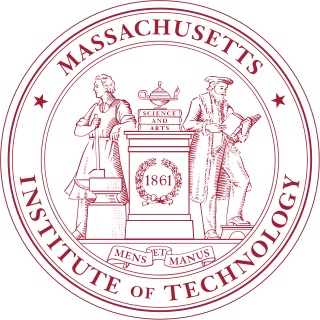
The Massachusetts Institute of Technology (MIT) is a private research university in Cambridge, Massachusetts, United States. Established in 1861, MIT has played a significant role in the development of many areas of modern technology and science.
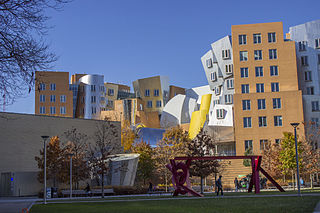
Stata Center, officially the Ray and Maria Stata Center and sometimes referred to as Building 32, is a 430,000-square-foot (40,000 m2) academic complex designed by architect Frank Gehry for the Massachusetts Institute of Technology (MIT). The building opened for initial occupancy on March 16, 2004. It is located on the site of MIT's former Building 20, which had housed the historic MIT Radiation Laboratory, at 32 Vassar Street in Cambridge, Massachusetts.

The smoot is a nonstandard, humorous unit of length created as part of an MIT fraternity pledge to Lambda Chi Alpha by Oliver R. Smoot, who in October 1958 lay down repeatedly on the Harvard Bridge between Boston and Cambridge, Massachusetts, so that his fraternity brothers could use his height to measure the length of the bridge.

Robert Merton Solow, GCIH was an American economist and Nobel laureate whose work on the theory of economic growth culminated in the exogenous growth model named after him.

The Sloan School of Management at Massachusetts Institute of Technology is the business school of the Massachusetts Institute of Technology, a private university in Cambridge, Massachusetts.
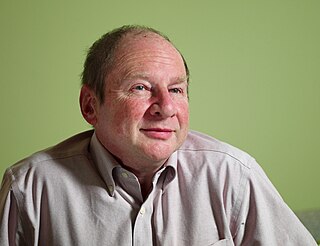
Harold Abelson is an American mathematician and computer scientist. He is a professor of computer science and engineering in the Department of Electrical Engineering and Computer Science at the Massachusetts Institute of Technology (MIT), a founding director of both Creative Commons and the Free Software Foundation, creator of the MIT App Inventor platform, and co-author of the widely-used textbook Structure and Interpretation of Computer Programs, sometimes also referred to as "the wizard book."

Computer Science and Artificial Intelligence Laboratory (CSAIL) is a research institute at the Massachusetts Institute of Technology (MIT) formed by the 2003 merger of the Laboratory for Computer Science (LCS) and the Artificial Intelligence Laboratory. Housed within the Ray and Maria Stata Center, CSAIL is the largest on-campus laboratory as measured by research scope and membership. It is part of the Schwarzman College of Computing but is also overseen by the MIT Vice President of Research.
The MIT Lincoln Laboratory, located in Lexington, Massachusetts, is a United States Department of Defense federally funded research and development center chartered to apply advanced technology to problems of national security. Research and development activities focus on long-term technology development as well as rapid system prototyping and demonstration. Its core competencies are in sensors, integrated sensing, signal processing for information extraction, decision-making support, and communications. These efforts are aligned within ten mission areas. The laboratory also maintains several field sites around the world.

The MIT Press is the university press of the Massachusetts Institute of Technology (MIT), a private research university in Cambridge, Massachusetts. The MIT Press publishes a number of academic journals and has been a pioneer in the Open Access movement in academic publishing.

Kendall/MIT station is an underground rapid transit station in Cambridge, Massachusetts. It is served by the MBTA Red Line. Located at the intersection of Main Street and Broadway, it is named for the primary areas it serves - the Kendall Square business district and the Massachusetts Institute of Technology (MIT). Opened in March 1912 as part of the original Cambridge subway, Kendall/MIT has two side platforms serving the line's two tracks. The Kendall Band, a public art installation of hand-operated musical sculptures, is located between the tracks in the station with controls located on the platforms. Kendall/MIT station is accessible. With 17,018 weekday boardings by a FY2019 count, Kendall/MIT has the fourth highest ridership among MBTA subway stations.

The Tech, first published on November 16, 1881, is the student newspaper at the Massachusetts Institute of Technology in Cambridge, Massachusetts. Editions are published biweekly on Thursdays throughout the academic year and about once a month over the summer. The Tech established an early presence on the World Wide Web, and continues to publish online in tandem with the print edition.

The MIT Museum, founded in 1971, is part of the Massachusetts Institute of Technology in Cambridge, Massachusetts. It hosts collections of holography, technology-related artworks, artificial intelligence, architecture, robotics, maritime history, and the history of MIT. Its holography collection of 1800 pieces is the largest in the world, though only a few selections from it are usually exhibited. As of 2023, works by the kinetic artist Arthur Ganson were the largest long-running displays; in 2024 they were replaced by a newer art installation, but some of Ganson's works were reinstalled elsewhere in the museum. There is a regular program of temporary special exhibitions, often on the intersections of art and technology.
MIT Tech Talk was the Massachusetts Institute of Technology's official newspaper from February 1957 until September 2009, when it ceased publication. It was written and published by the MIT News Office, both in print and online, with print copies distributed throughout campus free of charge. The publication schedule was roughly weekly, with an issue out most Wednesdays during the academic term.
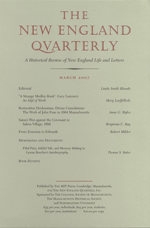
The New England Quarterly is a peer-reviewed academic journal consisting of articles on New England's cultural, literary, political, and social history. The journal contains essays, interpretations of traditional texts, essay reviews, and book reviews. The New England Quarterly was established in 1928 and is published by MIT Press for The New England Quarterly Inc., a nonprofit sponsored by the University of Massachusetts Boston and the Colonial Society of Massachusetts, and supported by the Massachusetts Cultural Council. MIT Press began publishing the journal in 2007.
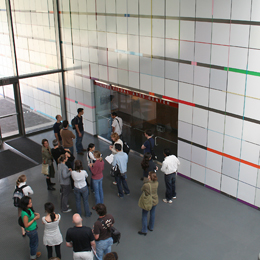
Established in 1950, the List Visual Arts Center (LVAC) is the contemporary art museum of the Massachusetts Institute of Technology. It is known for temporary exhibitions in its galleries located in the MIT Media Lab building, as well as its administration of the permanent art collection distributed throughout the university campus, faculty offices, and student housing.

John George Trump was an American electrical engineer, inventor, and physicist. A professor at the Massachusetts Institute of Technology (MIT) from 1936 to 1985, he was a recipient of the National Medal of Science and a member of the National Academy of Engineering. Trump was noted for developing rotational radiation therapy. Together with Robert J. Van de Graaff, he developed one of the first million-volt X-ray generators. He was the uncle of Donald Trump.
The Massachusetts Institute of Technology Police Department is the police agency charged with providing law enforcement to the campus of the Massachusetts Institute of Technology. The 168-acre (68.0 ha) campus extends over 1 mile (1.6 km) along the northern bank of the Charles River basin.


















